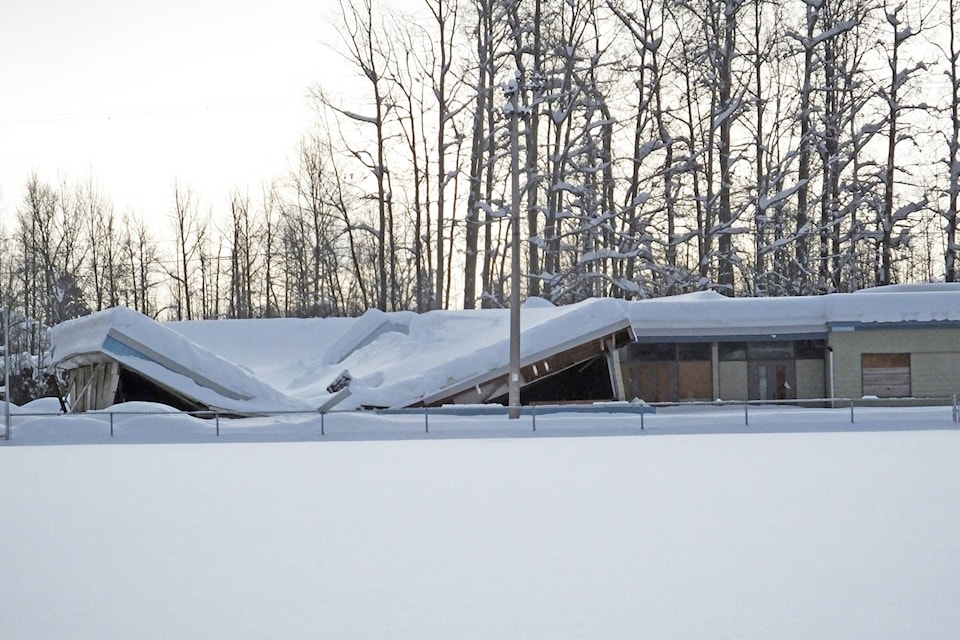The Town of Smithers has put out a public service announcement on roof snow clearing as some Bulkley Valley roofs have been caving in under repeated heavy snowfalls this winter.
The roof on the former Chandler Park school collapsed Wednesday night. And while it is not confirmed it was due to snow, the heated warehouse roof of Bulkley Valley Home Centre in Telkwa also collapsed earlier in the week.
Chandler property owner Paul Mott said in an email that section of the school was in the worst shape and had obvious structural compromises at the floor level.
“We were aware of this and it was going to have to be demolished anyway. We had it empty in preparation for its eventual demolition. The rest of the school is in much better shape. I will be continuing with the clean up in the spring; everything is shut down and the building is empty. So that was good that no one was hurt. I plan on building residential townhomes there soon,” wrote Mott.
The Regional District of Bulkley-Nechako issued a bulletin on roof snow loads:
Snow surveys recently conducted indicate that snow accumulations may be approaching the limits for the minimally designed buildings constructed prior to 1993.
The RDBN would like to advise residents within the RDBN to have their buildings examined for excessive snow accumulations. Residents are reminded that going onto roofs can be very hazardous and they should seek the assistance of a qualified contractor familiar with working on roofs.
If anyone has any questions regarding snow conditions, please contact the Building Inspectors at the Regional District office in Burns Lake at 250-692-3195 or 1-800-320-3339 for more information.
The RDBN also has an editable version of the Household Emergency Plan to download: rdbn.bc.ca/images/pdf/EmgServices/HouseholdEmgPlan.pdf.
Residents and business owners have been seen on top of their roofs clearing snow. The Town of Smithers had these tips:
(Click here for frequently asked questions document)
Homes built prior to 1985 or homes that are developing icicles or ice damming at the eaves may need some clearing. Attic ventilation — ridge vents, whirly vents, flat vents — that are blocked, may be restricting air flow that cools and removes moisture from the attic. Heat escaping from the house and trapped in attic spaces can melt snow at the shingles and cause a flow of water to the cold overhang at the soffits. So clearing vents is a place to start!
1. Do not shovel alone – have a spotter
2. Use fall-restraint or a rope safety line
3. Do not over-exert yourself
4. Remove snow evenly from the roof to avoid unbalanced loading
5. Do not shovel all the way to the roof surface – leave 50mm (2 inches)
6. COMMERCIAL BUILDING ROOFS—Do not clear onto public sidewalks or roadways unless barricades are set up, and follow up to clear the right of way for public safety.
MATH
The BC Building Code establishes the Ground Snow Load which is used to calculate the Roof Snow Load that engineers and builders factor in construction. The Ground Snow Load has changed over the past three decades: 1985—2.2 Kpa, 1998—2.7 Kpa, 2003—2.9 Kpa, 2006 to present—3.2 Kpa.
The Town of Smithers’ current ground snow load is 3.2 kPa plus 0.2 kPa rain component, for a total 3.4 kPa, or 69 lbs/ft2. For building design, this value is generally reduced by 40% for residential buildings and by 20% for commercial buildings, known as the specified roof snow loads. This equates to 41psf for residential and 55psf for commercial.
Pure water density is around 1000 kg (or one tonne) per cubic metre or 62.4 lbs per cubic foot. Newly fallen snow more typically weighs 70 to 150 kg per cubic metre (4.4 to 9.4 lbs/cubic foot). Typically winter snowpacks have a density of 200-300 kg per cubic metre (12.5-18.7 lbs per cubic foot).
If we use 300kg/m3 (18.7pcf), then the current design depth of snow on roofs is 2.2ft on residential and 2.9ft on commercial. Owners should consider removing the snow if the packed accumulated snow exceeds these depths. If heavy rains fall on these snow depths, the roof loading and risks of structure failure increase significantly.
Owners of older homes and buildings that were designed to a lighter snow load should consider removing snow at lower depths than those listed above.
